|
2 Comments
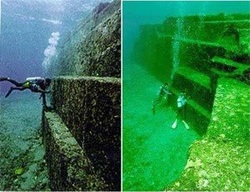 Yonaguni is a small island south-west of Okinawa in the Japanese archipelago. In 1988, scuba divers led by Kihachiro Aratake discovered an enormous stone structure on the seabed off the coast of Yonaguni. The structure lay more than 75 feet below the surface. Investigation showed it was 600 feet long, 450 feet wide and 90 feet high. The locals decided it was a natural formation. Ten years later, the experts weren't so sure. The first geologist to investigate the site was Professor Masaki Kimura of Ryuku University on Okinawa. In April 1998, he discovered a structure divided into five distinct layers and decided it had to be manmade. It is easy to see why. Underwater photographs and video footage reveal a stepped, ziggurat-like monument of extraordinary proportions. Each step is about 3 feet high with clean edges and sharp angles. There is also an archway and two parallel monoliths among other intriguing features like drainage channels. Further investigation led to the discovery of smaller satellite ziggurats near the main edifice. Each is about 30 feet wide and 6 feet high. Each appears to be constructed of stepped slabs. Divers also found what looks like a road surrounding the main structure. Robert Schoch, the American geologist who re-dated the sphinx, dived to examine the Yonaguni Monument and later commented that while natural water erosion and rock splitting might possibly produce a structure of this type, he had never seen anything quite like it before. Professor Kimura was even more forthcoming. He maintained bluntly that if the sharp steps were the result of natural erosion there would be debris on the seabed surrounding them. In fact, there is none.Conventional dating puts this Japanese culture at a time when scientists thought only primitive hunter gatherers worked on the land and had very limited knowledge. We know this is proof of a flood, and of the global scale that it occured in Noah's time. 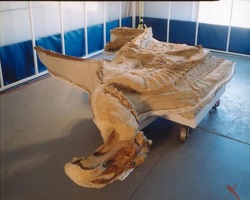 Leonardo the Edmontosaurus mummy is one of several well preserved dinosaur mummies found to date. We know that in order for a fossil to form, it needs to be covered quickly before decomposition sets in. This points to a flood as we would expect to see. Please click on the album to see more examples like this one. 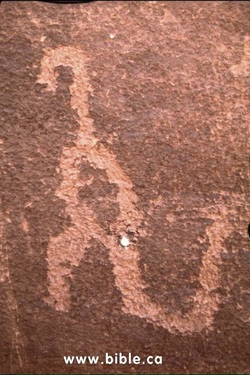 Ancient Native American art on a cave wall in the Grand Canyon. If man and dinosaurs lived millions of years apart, how can finds like this be explained? After being tested, this particular find was found to have the geuine buildup from the elements called pettina. Pettina is what makes the difference between a genuine article, and a falsified one, typically. This one is indeed genuine from what has been gathered through the years. 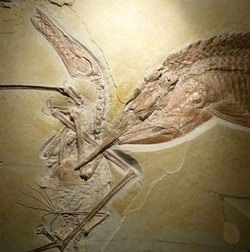 This is an amazing fossil of a large ancient fish with a bird in it's mouth, obviously ready to gobble down. Then it suddenly dies, and neither the bird OR the fish gets eaten. How does this along with thousands of other fossils of sudden death point to gradualism and slow processes? Remember, there were some very large predators out there who were always looking for a meal. And this was a bonus!  One of the things we see in the Bible are scientific facts presented long before they were discovered by man. This would make perfect sense, since the Bible is the inspired Word of God. God the Creator knew all these things before we did because He created the universe!... God said to Abraham 'Look now toward heaven, and count the stars if you are able to number them.' And He said to him, 'So shall your descendants be.'(Gen 15:5)". And through the prophet Jeremiah, 'As the host of heaven (stars) cannot be numbered, nor the sand of the sea measured, so will I multiply the descendants of David My servant (Jeremiah 33:22). And finally, in the New Testament "Therefore from one man, were born as many as the stars of the sky in multitude innumerable as the sand which is by the seashore. (Hebrews 11:12)"Before the invention of the telescope in 1608, scientists throughout history, including the famous astronomer Ptolemy (150 AD), taught that the total number of stars in the heavens was under 3000. On a clear night the naked eye can only count about 1000 stars. However, because of telescopes such as the Hubble, we now know there are countless billions upon billions of stars in the universe - just as God had revealed to us several thousand years ago through the Bible.  Four, six and eight spoked wheels have been found under the Red Sea. These wheels were typical of the wheels used in the 18th Dynasty at the time of Moses and the Red Sea Exodus. Archeologists recovered the hub of a wheel with the remains of eight spokes and gave this significant find to Nassif Mohammed Hassan, Director of Antiquities in Cairo. Mr. Hassan immediately identified the artifact as a chariot wheel dating over 3500 years ago during the 18th Dynasty, the only time the ancient Egyptians used an eight spoked wheel. The hub and spokes are on display in Cairo, Egypt 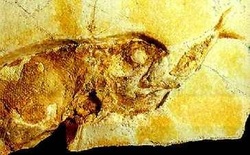 The tail of this smaller fish can be seen clearly, protruding from the mouth of the larger fish. Many similar specimens are known from several localities around the world. In some cases, fish have been buried and fossilized so rapidly that even the delicate soft tissues have been preserved. The Santana Form-ation of Brazil contains fish whose gills and muscles are so perfectly preserved that geologists believe they were fossilized within five hours of death! It takes rapid burial (by a flood) to preserve these specimens. Something that directly defies evolutionists millions of years. |
Archives
August 2018
Categories
All
|
- Home
- God
-
Bible
- Is the Bible True?
- What Makes the Bible So Special?
- How we got the Bible?
- Is the Bible Inerrant and Infallible?
- Contradictions in the Bible?
- Were Some Books Left Out?
- Undesigned Coincidences
- Archaeology
- Holy Lands
- Prophecies of the Bible
- Old Testament Overview
- New Testament Overview
- Early Church History
- Eye Witness Bible
- Timeline
- Can you prove the Bible?
- Read the Bible
-
Jesus
- Did Jesus Exist?
- Did Jesus claim to be God?
- What is the Trinity?
- One Solitary Life
- Jesus in the Old Testament
- Messianic Prophecies
- Miracles
- RESURRECTION >
- Why is Jesus the only way?
- Why Trust Jesus?
- What about those who never heard? >
- Near Death Experience
- End Time Prophecies
- The Great Commission
- Christians who Changed The World
- Good News
- Worldview
-
Creation
-
Hard Topics
- Is it ok to Doubt?
- Evil & Suffering
- Hell
- Violence in the Bible?
- Is God Immoral for Killing the Canaanites?
- Is God Different in the OT & NT?
- Slavery in the Bible?
- Hypocrites >
- Does Birthplace Determine Belief?
- Can God Make a Rock so Big He Can't Lift It?
- Why does God not answer prayers?
- Why Don’t More People Believe in God?
- How Were People Saved Before Jesus?
- Is Christianity a Copycat Religion?
- People who mocked God and Died.
- Why Did God Create People He Knew Would Reject Him?
- Paul's Opinion or Inspired?
- Are Your Beliefs Biblical?
- Council of Nicaea
- Ethical
-
Defenders of the Faith
- Institute for Creation Research
- Dr. Sean McDowell
- Detective J. Warner Wallace
- Expedition Bible - Joel Kramer
- DeBunked Ministries
- Dr. Frank Turek
- Ray Comfort
- Bobby Conway
- Steve Lee
- Mark Spence
- Lee Strobel, Journalist
- Josh McDowell
- Dave Sterrett
- Blake Giunta
- Impact 360 Institute
- Dave Stotts
- Dr. James Nored
- Natasha Crain
- Biblical Science Institute
- Reasonable Faith
- Resources
- Contact Us
Proudly powered by Weebly













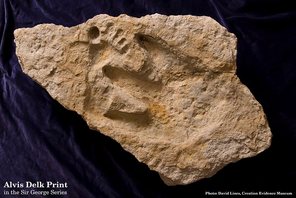
 RSS Feed
RSS Feed